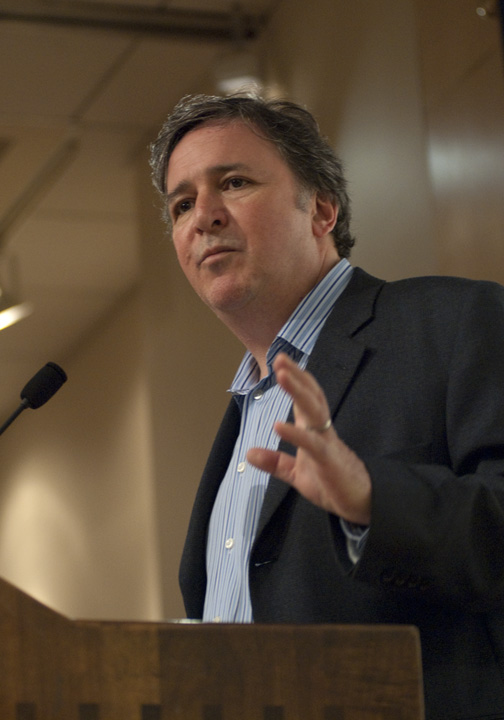The scattering of raised hands of unemployed journalists in the audience at Jonathan Weber’s presentation Wednesday about his new Bay Area journalism venture was a reflection of the dire situation facing media professionals.
Carl Hall, an organizer with the Northern California Media Workers Guild, broke the tension in his introduction to Weber, the much-sought-after editor of the Bay Area News Project: “I thought I’d save a lot of time by answering one question I know everyone has … the answer is, yes. You can all get a job at the Bay Area News Project.” The catch, Hall said, is there are only 15 jobs. “You get to share all those jobs.”
Weber has had much experience with startup media companies. He previously was co-founder and editor-in-chief of The Industry Standard, a weekly magazine that chronicled the dot-com boom, and most recently, founder and CEO of New West, a Web-based publishing company focused on issues of the Rocky Mountain region.
The new Bay Area nonprofit venture will operate in partnership with The New York Times and the UC Berkeley Graduate School of Journalism and will begin sometime in the late spring, according to Weber. The Web-centered publication, whose mission is “to foster civic engagement by providing best-in-class, original journalism” for the Bay Area, drew a crowd of more than 100 people to a question-and-answer session at the World Affairs Council in San Francisco.
Weber presented a contrarian point of view on modern media: Technology heralds the rebirth, of journalism, not its death.
What most in the audience seem to want to know about the project was his hiring strategy. He will take an “organic approach,” finding people who work well together, and then piece it together from there rather than drawing “boxes” and finding people to fill them, he said.
With widespread cutbacks in the news industry, the project has been inundated with applications even before a single job has been posted. Weber must embark on sorting through the stacks of resumes that arrived in the San Francisco offices even before he did last month.
“I have to get my arms around what was already there,” he said.
The Bay Area News Project, Weber said, looks to “reinvent the metro newspaper” (and not simply be a “prettier version of the Chronicle Web site,” as Lois Beckett of SF Weekly questioned). Weber said the site will be innovative stylistically, written with clarity and designed with a hierarchy not typically found in today’s news sites.
The newsroom will have three components. First, an enterprise reporting staff covering traditional “core” beats. Second, an outward focus, nurturing relationships with other, potentially partner news organizations. Third, a “portfolio of products mostly in the electronic realm,” including the Web page, mobile and real-time coverage.
The buzzword for the night was “productizing.” “The newspaper is a product that has not changed in a long time,” he said. But what hasn’t fully been explored is how people read the paper. How can a Web site do different things for different people? With the new “technological opportunity” he said, there can be a greater understanding of how people use a product, how they relate and what they get from an online publication. That understanding leads to higher Web traffic Weber’s measure of user interest.
Despite persistent prodding from the audience, little was revealed about what explicitly the staff will cover.
“There’s a lot of opinion out there,” Weber said, so it will not be the primary focus. The same goes for sports and food beats. Weber sidestepped specifics with open-ended answers, like his response to weekly productivity: “We’ll have, 30, 40, 50 stories a week, something like that.”
"It’s just like what he said,” said Karen Hershenson, a former Contra Costa Times editor and columnist in the audience who now works in public relations. “Newspapers have ossified.” He “seemed like a visionary,” she said. “There may be a way to integrate innovation.”
Weber is forging ahead without knowing his exact destination — essentially the reconstruction of the business model of journalism.
“Quality journalism can and will find an audience,” Weber said. “Despite all the problems in the business, that core fact remains, and there is really more demand than ever. And ultimately, that will result in a renaissance.”










